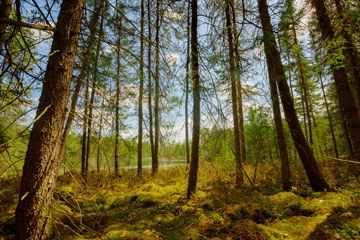Big Swamp
No. 512

Photo by Josh Mayer
Big Swamp is a vast peatland that harbors extensive stands of muskeg, open bog, poor fen, sedge meadow, and an undeveloped seepage lake. In the southern and central portion of the site is a muskeg community with scattered, stunted black spruce and tamarack with ericaceous shrubs, sedges, and sphagnum. Jack pine is occasionally present. Characteristic species are bog rosemary, bog laurel, leather-leaf, small cranberry, black chokeberry, bog birch, bog willow, few-seeded sedge, and creeping sedge.
Areas with a more dense cover of spruce support species such as Labrador tea, three-seeded sedge, tussock cotton grass, and three-leaved Solomon's-seal. The 62-acre Clear Lake is a seepage lake containing very soft water. Adjacent to the lake is a boggy, sphagnum lawn that features pitcher plants, arrowgrass, round-leaved sundew, and a rare orchid. Near the southern upland border, tamarack is much more dominant than spruce and is associated with alder, northern blue-flag iris, and mountain holly.
The westernmost section contains a gently sloping sandy peninsula that supports a dry-mesic forest dominated by red pine, red oak, and white pine. The moderately dense shrub layer is comprised primarily of beaked hazelnut. The low shrub and herbaceous layer include early low blueberry, pipsissewa, bracken fern, Canada mayflower, American starflower, and running club-moss.
Uncommon plants are early coralroot and false beech drops. Of note are two undeveloped waterbodies that support numerous rare plants. A 22-acre seepage lake (Swanson Lake) contains extremely soft water that supports a unique plant assemblage that is specially adapted to infertile water. Plants include water lobelia, resupinate bladderwort, and lake quillwort. The smaller 10-acre bog pond and wetlands support rare plants such as hidden-fruited bladderwort and Farwell's milfoil. Avifauna includes palm warbler, black-throated green warbler, pine warbler, hermit thrush, ovenbird, winter wren, sedge wren, Lincoln's sparrow, and northern harrier. Big Swamp is owned by the DNR and was designated a State Natural Area in 2007.
Very few State Natural Areas have public facilities, but nearly all are open for a variety of recreational activities as indicated below. Generally, there are no picnic areas, restrooms, or other developments. Parking lots or designated parking areas are noted on individual SNA pages and maps. Trails, if present, are typically undesignated footpaths. If a developed trail is present, it will normally be noted on the SNA map under the Maps tab. A compass and topographic map or a GPS unit are useful tools for exploring larger, isolated SNAs.
The good majority of SNAs are isolated and have few or no facilities. Some SNAs have vehicle access lanes or parking lots, but their accessibility may vary depending on weather conditions. Parking lots and lanes are not plowed during winter. Hiking trails may be nonexistent or consist of undeveloped footpaths. A GPS unit or compass and a detailed topographic map are useful tools for exploring larger SNAs.
Entrance fees: Except for Parfrey's Glen, the Cambrian Outlook in the Dells of the Wisconsin River, SNAs within State Parks and some within State Forests, all other DNR-owned SNAs do not have any admission fees. For more information, see Wis. Admin. Code NR 45. For non-DNR-owned SNAs, we are unaware of any vehicle or admission fees. However, please contact the landowner for more information.
Allowable activities: DNR-owned land
The activities listed below are generally allowed on all DNR-owned SNA lands. Exceptions to this list of public uses, such as SNAs closed to hunting, are noted above and posted with signs on the property site.
- Hiking
- Fishing
- Cross country skiing
- Hunting
- Trapping
- Scientific research (permit required)
- Outdoor education
- Wild edibles (What is this?)
- Pets (Rules)
- Wildlife viewing
Prohibited activities: all SNAs
- Camping and campfires
- Collecting of animals (other than legally harvested species), non-edible fungi, rocks, minerals, fossils, archaeological artifacts, soil, downed wood, or any other natural material alive or dead.
- Collecting for scientific research requires a permit issued by the DNR
- Collecting of plants including seeds, roots or other non-edible parts of herbaceous plants such as wildflowers or grasses
- Geocaching
- Horseback riding
- Rock climbing
- Vehicles, including bicycles, ATVs, aircraft, and snowmobiles except on trails and roadways designated for their use.
For rules governing state-owned SNAs and other state lands, please consult Chapter NR 45 Wis. Admin. Code [exit DNR].
Location
Within the Northern Highland-American Legion State Forest, Oneida County. T38N-R8E, Sections 1-4, 10, 11, 12. T38N-R9E, Section 7. T39N-R8E, Sections 34, 35, 36. 2,914 acres.
Driving directions
From McNaughton, go east on Bridge Road for 0.8 miles, then north and east on Black Lake Road for 2.9 miles, then continue east on Ranch Road for 0.7 miles, then north on Muskellunge Lake Road for 2.3 miles. Park and walk northeast into the site.
The DNR's state natural areas program is comprised of lands owned by the state, private conservation organizations, municipalities, other governmental agencies, educational institutions, and private individuals. While the majority of SNAs are open to the public, access may vary according to individual ownership policies. Public use restrictions may apply due to public safety, or to protect endangered or threatened species or unique natural features. Lands may be temporarily closed due to specific management activities.
Users are encouraged to contact the landowner for more specific details. The data shown on these maps have been obtained from various sources, and are of varying age, reliability, and resolution. The data may contain errors or omissions and should not be interpreted as a legal representation of legal ownership boundaries. To create your custom map where you can zoom to a specific location, please use the DNR's Mapping Application.
Big Swamp is owned by: Wisconsin DNR
